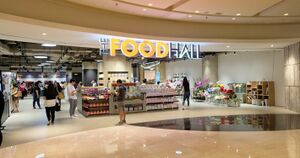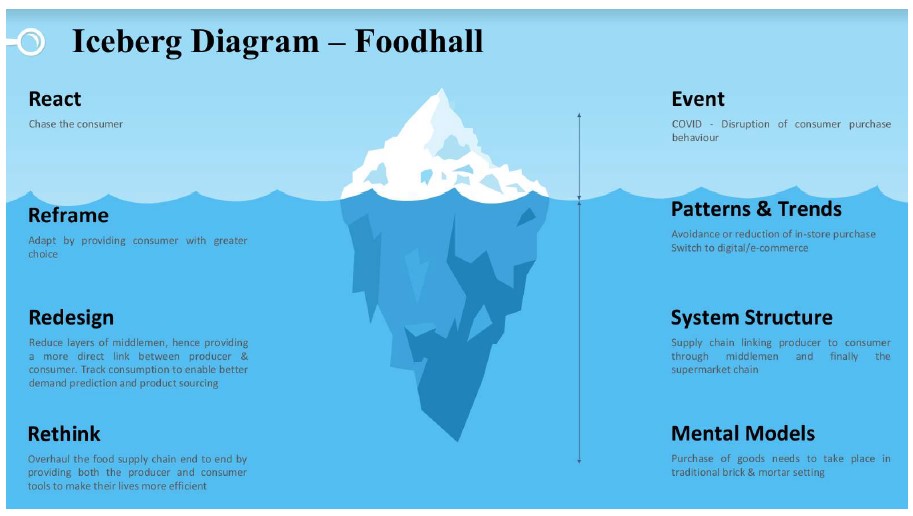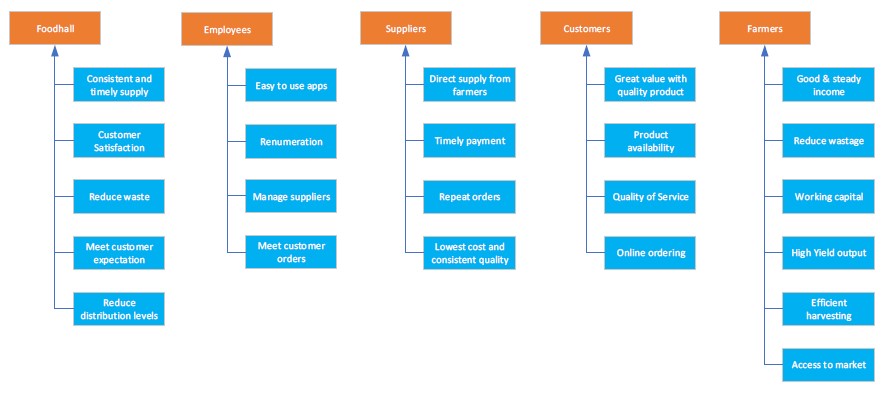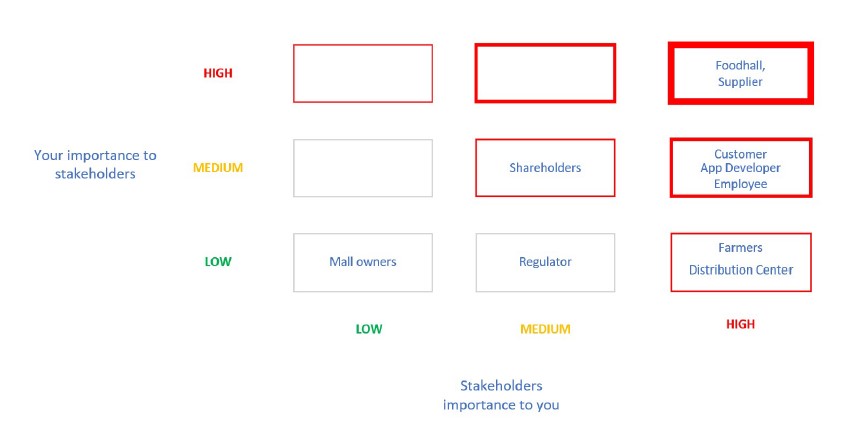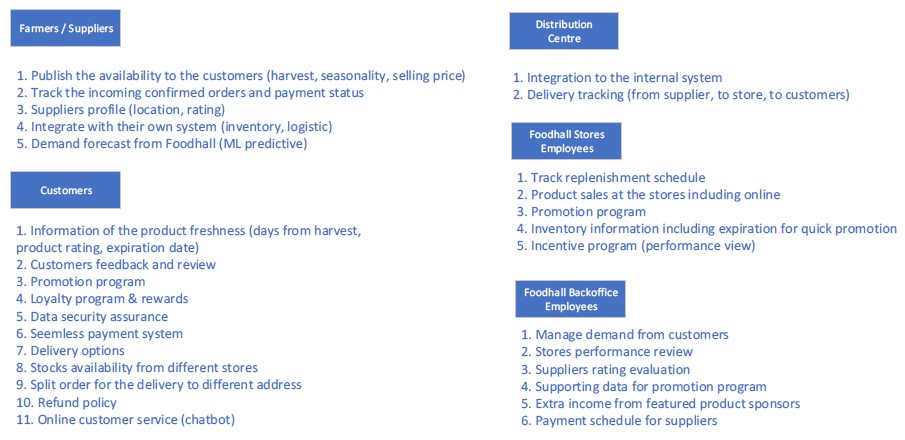Difference between revisions of "HDX Team 3 - Smart Grocery"
imported>Sharnyo |
imported>Sharnyo |
||
| Line 78: | Line 78: | ||
=Logical Framework= | =Logical Framework= | ||
[[File:Logframe.jpg|left | [[File:Logframe.jpg|left]] | ||
=Systems Interface= | =Systems Interface= | ||
Revision as of 08:26, 31 July 2021
Challenge Project Background
The Foodhall is one of PT. Mitra Adiperkasa Tbk business segments. The business is grocery retail with two types of premium supermarket concepts: The Foodhall, a large format supermarket and Daily Foodhall, a smaller format supermarket located mostly in residential areas. Our project team has been tasked to examine Foodhall’s current retail strategy and propose viable solutions for The Foodhall.
The COVID-19 pandemic has posed numerous challenges to businesses especially those that are operating as brick and mortar stores. It is just one of the factors listed by our stakeholders as motivation for a rethink on retail strategy. Another consideration is how Foodhall can structure an end to end solution for its supply chain that would reduce wastage, reduce middlemen, and enhance the experience for its suppliers and consumers by offering fresh foods at the best possible price and quality.
The team got down to our challenge by first looking at the system, namely the supply chain. We used the iceberg model to identify patterns and trends as well as the mental models, we also looked at our system problem statement to define our why of the challenge as well as the what and how. We came up with the stakeholders most relevant to the challenge at hand and their importance relative to Foodhall. Descriptive goals were then drawn up and metrics for measurement to keep us aligned to success led to the next steps which was to develop an app that would track purchase and supply data and democratise this across the entire supply chain to achieve better provision of fresh foods to the end user and reduce waste. These various steps are highlighted in the next sections.
Team Members
Research references
To gain a better sensing of the project and being continuous learners, several sources of information proved useful to our team. These articles allowed us to gain insights into the best practises of supply chain management, in particular to the farming and grocery business
https://hackerfarm.jp/2019/04/the-food-chain-japanese-agriculture-from-farm-to-supermarket/
https://www.relexsolutions.com/resources/managing-grocery-retail-supply-chains/
https://www.gartner.com/smarterwithgartner/3-steps-to-a-digital-supply-chain/
Iceberg Model (Systems View)
The figure 1 below shows our iceberg model for our complex system from a consumer standpoint. From the business standpoint, after speaking with our stakeholder Foodhall, we understand that there is sometimes a separation in ordering patterns at the store level as opposed to head office as well as a reliance on manual modes or ordering. Hence, it would be of value to create a unified end to end solution that would be able to handle both store level and head office level ordering and supply management. In our redesign, some stakeholders such as the middlemen suppliers might be displaced especially if they cannot consistently deliver value to the produce supply chain, or integrate into the idea of information exchange and systems integration but that this exercise is worth the effort as it would bring in more predictable outcomes such as a more responsive supply chain.
Figure 1 : Iceberg Diagram
Goal Statement
Our team examined the goal of the challenge and how to deliver value to the project that is representative of real success. The ‘To, By and Using’ goal statement we established is:
- To : Reduce wastage of perishable produce, get low price for customer while improving farmers’ welfare. Reduce wastage of perishable produce, get low price for customer while improving farmers’ welfare
- By : Shortening the produce supply chain through predictive orders
- Using : An on-demand digital ordering system
Stakeholders Analysis
For an end to end solution, we identified at least 10 stakeholders. These stakeholders are relevant to the Foodhall challenge now and into the future. Figure 2 illustrates these stakeholders and their respective needs.
Figure 2 : Stakeholders Analysis
The stakeholders can be further defined as those who might be directly involved in the supply chain, for instance, the Farmers, Suppliers, the Distribution Centre, Foodhall itself as challenge project owner as well as those who are potentially indirectly connected such as the App Developer, Regulator, Shareholders and Mall Owners and finally both directly and indirectly, namely the Employees of Foodhall since they might be based in back office (head office) and have functions of pushing down supplies to the various store locations or front end staff who might need to make or receive stock replenishments.
Stakeholders Descriptive Goals and Metrics
We identified 14 goals for the project. 7 of these were initially deemed critical to the challenge project. This is illustrated by Figure 3. The goals in Figure 3 are not listed in sequential order. However after speaking with the stakeholder Foodhall, we now understand that a separate system is already in the works for a consumer app.
This led the team to reexamine our ‘why’ of the project. We scaled down the scope of the project to only focus on the supply side. Hence the team worked on the descriptive goals that are essential to delivering an optimized supply chain that would allow for data flows between the farmers, suppliers, distribution center and Foodhall. With an increased information exchange and demand aggregation, more visibility is afforded through the entire system structure providing assurances to the farmers and suppliers as well as to Foodhall and helps to reduce wastage by only catering for demand generated by the end customer. In this way, our project is quite literally Happy Digital X as we are addressing the financial well being of the farmers and suppliers through a more predictable order which should make them happier in the longer term whilst tying up the ecosystem through a digital solution.
In our revision, goals 3, 7, 8, 1 and 2 are critical in ensuring an efficient end to end supply chain.
Figure 3 : Descriptive Goals
Pairwise Interactions
From these ten stakeholders, we did a pairwise interaction based on a 3 by 3 grid. Figure 4 illustrates this.
Figure 4 : 3x3 matrix
The Foodhall and Suppliers are of highest importance to the project. Foodhall, for obvious reasons since they hold the consumption data, trends and patterns as well as the business requirements. The supplier because they are a cog in the system where they hold valuable intermediary data and represent the bridge between the farmers and the distribution centre. Of medium importance is the customer as they represent the demand side and help the project generate revenue from their orders. The app developers are of similar importance as they will be integrating all of the business requirements into an enterprise solution (SAAS) that would handle orders and order tracking for stakeholders such as the Foodhall, farmer, supplier, distribution centre. Finally employees came in at medium, as their buy-in and familiarity with any eventual system is critical for the success of implementation.
Value Propositions
Our team defined the value that a responsive supply chain would bring to our most important stakeholders. For farmers and suppliers, it would mean an opportunity to share harvest details and produce availability to Foodhall. An integrated system would also give visibility to the farmers and suppliers on incoming orders and payments to increase trust in the system.
Figure 5 maps the value proposition or benefits to each of the five stakeholders. However, as mentioned earlier, Foodhall is developing a separate consumer app, so our challenge project will focus on the four stakeholders groups: farmers & suppliers, distribution center and Foodhall
Figure 5: Benefits of an end-to-end digital supply chain system
Logical Framework
Systems Interface
The interface between different systems i.e. internal and external.
